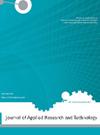Circularly Polarized UWB Antenna with Question Mark Shaped Patch for GPR Applications
Q3 Engineering
Journal of Applied Research and Technology
Pub Date : 2022-07-01
DOI:10.22201/icat.24486736e.2022.20.3.1637
引用次数: 2
Abstract
A novel Circularly Polarized (CP) Ultra Wideband (UWB) antenna for Ground Penetrating Radar (GPR) applications is presented and discussed in this paper. The proposed antenna is constructed by a question mark shaped radiating patch and a truncated ground plane. A prototype of the designed antenna is fabricated on the FR4-substrate with an overall volume of 0.7λ0×0.793λ0×0.035λ0 at 7 GHz. The simulated results show that the designed antenna has an Impedance Bandwidth (IBW) ranging from 3.14 GHz to 11.88 GHz (116.38%). The CP feature is analyzed and discussed confirming that the antenna maintains a CP radiation characteristic in a broadband with a 3-dB Axial Ratio Bandwidth (ARBW) ranging from 4.13 GHz to 9.28 GHz (76.81%). The measurements were done by utilizing a well calibrated R&S®ZNB Vector Network Analyzer indicating that the fabricated prototype has an IBW nearly ranging from 3.47 GHz to 12.11GHz (110.91%). The results are favorable that ensure the usefulness of this antenna for GPR applications.用于探地雷达应用的带问号贴片的圆极化超宽带天线
本文提出并讨论了一种适用于探地雷达的新型圆极化超宽带天线。所提出的天线由一个问号形状的辐射贴片和一个截断的接地平面构成。设计的天线原型在FR4衬底上制作,在7 GHz下总体积为0.7λ0×0.793λ0×0.035λ0。模拟结果表明,所设计的天线的阻抗带宽(IBW)范围为3.14 GHz至11.88 GHz(116.38%)。对CP特性进行了分析和讨论,证实了天线在4.13 GHz至9.28 GHz(76.81%)的3dB轴比带宽(ARBW)的宽带中保持CP辐射特性R&S®ZNB矢量网络分析仪表明,所制造的原型的IBW几乎在3.47 GHz到12.11GHz之间(110.91%)。结果是有利的,确保了该天线在探地雷达应用中的有用性。
本文章由计算机程序翻译,如有差异,请以英文原文为准。
求助全文
约1分钟内获得全文
求助全文
来源期刊

Journal of Applied Research and Technology
工程技术-工程:电子与电气
CiteScore
1.50
自引率
0.00%
发文量
0
审稿时长
6-12 weeks
期刊介绍:
The Journal of Applied Research and Technology (JART) is a bimonthly open access journal that publishes papers on innovative applications, development of new technologies and efficient solutions in engineering, computing and scientific research. JART publishes manuscripts describing original research, with significant results based on experimental, theoretical and numerical work.
The journal does not charge for submission, processing, publication of manuscripts or for color reproduction of photographs.
JART classifies research into the following main fields:
-Material Science:
Biomaterials, carbon, ceramics, composite, metals, polymers, thin films, functional materials and semiconductors.
-Computer Science:
Computer graphics and visualization, programming, human-computer interaction, neural networks, image processing and software engineering.
-Industrial Engineering:
Operations research, systems engineering, management science, complex systems and cybernetics applications and information technologies
-Electronic Engineering:
Solid-state physics, radio engineering, telecommunications, control systems, signal processing, power electronics, electronic devices and circuits and automation.
-Instrumentation engineering and science:
Measurement devices (pressure, temperature, flow, voltage, frequency etc.), precision engineering, medical devices, instrumentation for education (devices and software), sensor technology, mechatronics and robotics.
 求助内容:
求助内容: 应助结果提醒方式:
应助结果提醒方式:


